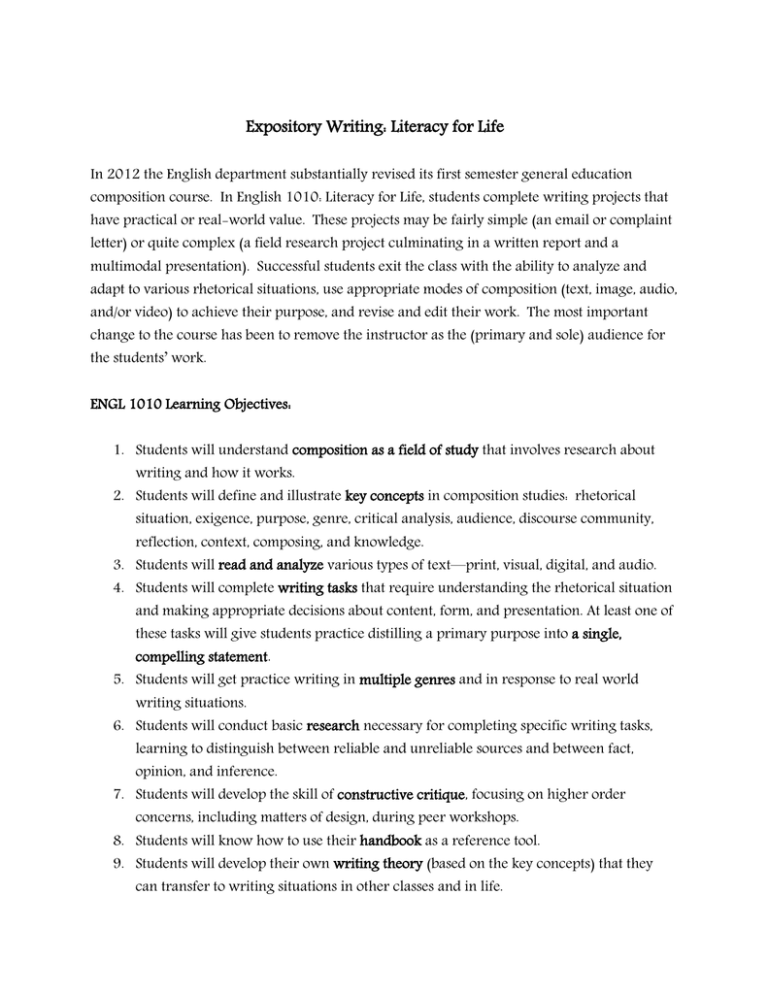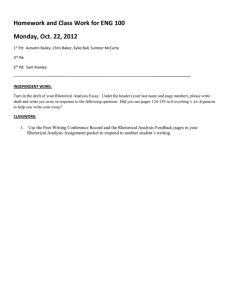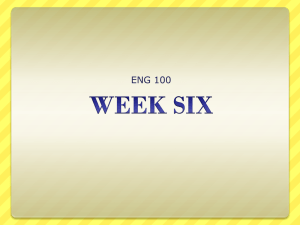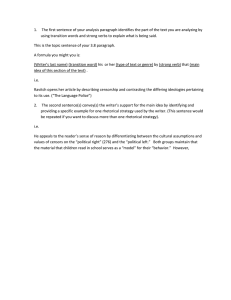Expository Writing: Literacy for Life
advertisement

Expository Writing: Literacy for Life In 2012 the English department substantially revised its first semester general education composition course. In English 1010: Literacy for Life, students complete writing projects that have practical or real-world value. These projects may be fairly simple (an email or complaint letter) or quite complex (a field research project culminating in a written report and a multimodal presentation). Successful students exit the class with the ability to analyze and adapt to various rhetorical situations, use appropriate modes of composition (text, image, audio, and/or video) to achieve their purpose, and revise and edit their work. The most important change to the course has been to remove the instructor as the (primary and sole) audience for the students’ work. ENGL 1010 Learning Objectives: 1. Students will understand composition as a field of study that involves research about writing and how it works. 2. Students will define and illustrate key concepts in composition studies: rhetorical situation, exigence, purpose, genre, critical analysis, audience, discourse community, reflection, context, composing, and knowledge. 3. Students will read and analyze various types of text—print, visual, digital, and audio. 4. Students will complete writing tasks that require understanding the rhetorical situation and making appropriate decisions about content, form, and presentation. At least one of these tasks will give students practice distilling a primary purpose into a single, compelling statement. 5. Students will get practice writing in multiple genres and in response to real world writing situations. 6. Students will conduct basic research necessary for completing specific writing tasks, learning to distinguish between reliable and unreliable sources and between fact, opinion, and inference. 7. Students will develop the skill of constructive critique, focusing on higher order concerns, including matters of design, during peer workshops. 8. Students will know how to use their handbook as a reference tool. 9. Students will develop their own writing theory (based on the key concepts) that they can transfer to writing situations in other classes and in life. ENGL 1010 Teaching Objectives 1. Provide a written rationale for the course. Connect the practice of expository writing to writing students will do in other coursework, the workplace, and their everyday lives. 2. Pace your course so that students read and write throughout the 15 week semester. Get the most out of your textbooks. 3. Introduce composition as an academic field of study by presenting a sample of research on writing. (Examples: Andrea Lundsford’s “Mistakes are a Fact of Life: A Comparative National Study,” Peter Elbow’s “Inviting the Mother Tongue,” Nancy Sommers’s “The Novice as Expert: Writing the Freshman Year,” and Deborah Brandt’s “Literacy in American Lives.”) 4. Teach students the rhetorical triangle—exigence/purpose/audience. 5. Reinforce understanding of key concepts (particularly the rhetorical situation) through reading. Show students how to annotate model/mentor texts, focusing on both content and form. Put emphasis on understanding the writer’s purpose, main idea/argument, and rhetorical strategies. Teach students that writing is about making choices that reflect an understanding of audience. 6. Give students writing-to-learn opportunities. 7. Present students with writing tasks/projects that require consideration of the key concepts. These writing tasks should (1) have real world implications and (2) be expository in nature—writing to inform, instruct, clarify, define, describe, assess, or evaluate. A typical sequence of writing assignments: Personal Statement, Profile of a (student) Organization, Op-Ed or Review, Rhetorical/ Analysis or Report. 8. At least one writing task should require that students distill a primary purpose into a single, compelling statement and order and develop major points in a reasonable and convincing manner based on that purpose. This task might be an email, a letter, an op-ed, a report, or an essay exam. Acknowledge that thesis statements are often informative and sometimes implied. 9. Give students instruction in basic research, e.g. finding definitions, explanations, facts. Teach them how to distinguish between reliable and unreliable sources of information and between fact, opinion, and inference. Introduce the idea of academic integrity—when and how to document source material. (You might have them compare the “same” information gleaned from several different sources—Wikipedia, a reference volume, and a website.) 10. Introduce basic concepts of design. Do not require strict adherence to MLA formatting unless called for by the rhetorical situation. 11. Use workshops to reinforce the key concepts: What is the student writer’s purpose? Who is the audience for this work? What is the relationship between form and content? What is the work this writing is doing? How can it do this work more effectively? Students should analyze and annotate their peers’ writing in the same way they analyze and annotate the mode (mentor) texts. Whenever possible, position students as evaluators, e.g. for op-ed drafts, peers are members of the editorial board of the newspaper. 12. Teach students to revise with attention to higher order concerns and to edit for clarity. 13. Grade students on process (no more than 30%) and product (at least 70%). 14. Use Easy Writer for 5 minute mini-lessons. Do not teach grammar or mechanics out of the context of an actual student’s writing. 15. Use the final exam period for formal presentations of students’ work.



